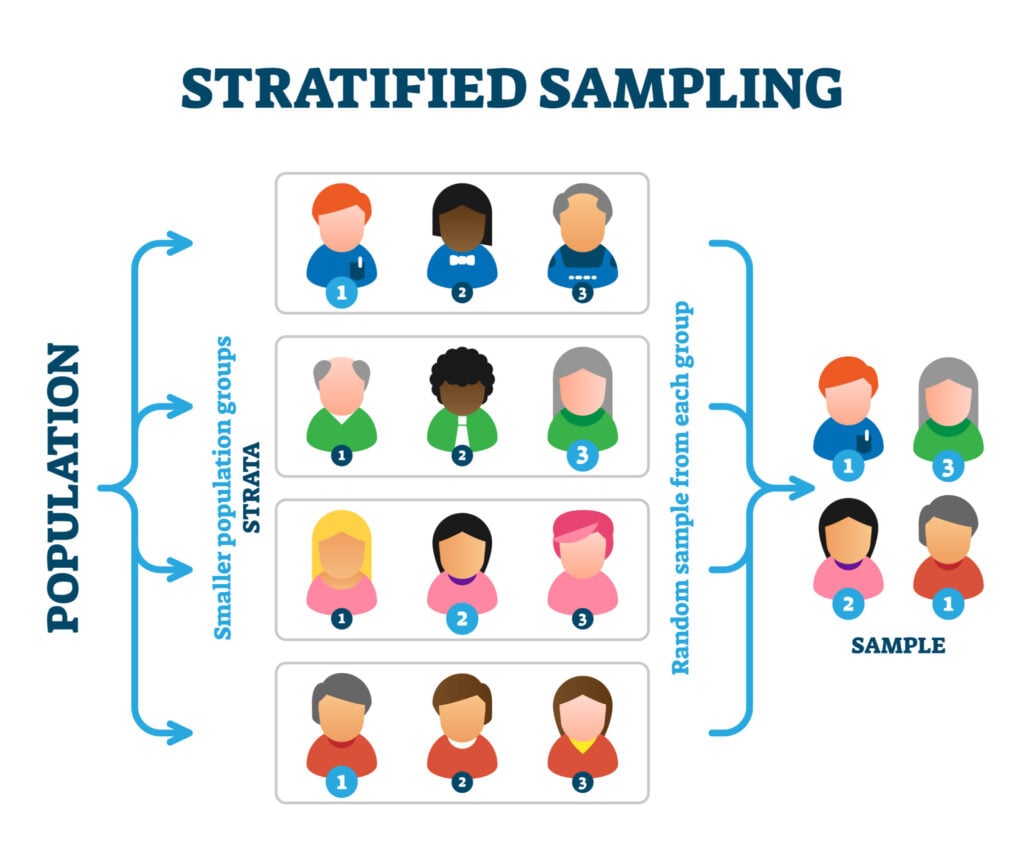These shared characteristics can include gender, age, sex, race, education level, or income.

The process of classifying the population into groups before sampling is called stratification. The strata must be mutually exclusive, and all members of the population can only be in one stratum.
When stratifying, researchers tend to use proportionate sampling, where they maintain the correct proportions to represent the population as a whole.
For example, if the larger population contains 40% history majors and 60% English majors, the final sample should reflect these percentages.
Disproportionate sampling is typically only used when studying an underrepresented group.
Applications
- When studying polling of elections, population demographics, or life expectancy.
- When studying the income of varying populations or the income for different jobs across a nation.
- When time is limited, or budgeting is tight as stratified sampling is quicker and cheaper than many other sampling methods.
- When the samples of a population vary drastically as forming strata helps organize a group of people.
- When researchers do not have access to an entire population.
Technique
- Define your population of interest and choose the characteristic(s) that you will use to divide your groups.
- Divide your sample into strata depending on the relevant characteristic(s). Each stratum must be mutually exclusive, but together, they must represent the entire population.
- Define the sample size for each stratum and decide whether your sample will be proportionate or disproportionate. The sample size in each stratum should ideally be in proportion to the members of that group within the target population or sampling frame.
- Draw a random sample from each stratum and combine them to form your final sample.
Example Situations
- Public Health Studies: To understand the incidence of disease across different age groups, the population could be stratified into different age brackets (e.g., 0-18, 19-35, 36-50, 51+).
- Investigating the relationship between average travel frequency, trip mode structure, and the characteristics of residential areas (Shi, 2015).
- Examining the prevalence and psychological sequelae of childhood sexual and physical abuse in adults from the general population (Briere & Elliott, 2003).
- Evaluating the usefulness of personality traits in explaining and predicting entrepreneurship (Llewellyn & Wilson, 2003).
- Examining women’s involvement in multiple roles in relation to 3 stress indices: role overload, role conflict, and anxiety (Barnett & Baruch, 1985).
- Studying perceptions of drinking water quality at four locations in Western Australia (Syme & Williams, 1993).
Advantages
Efficient and manageable
By organizing a population into groups with similar characteristics, researchers save data collection time and can better manage a sample that would otherwise be too large to analyze.
Cheap
The research costs for this sampling method are minimized as researchers save money by dividing a large population into smaller groups containing similar members rather than sampling every individual of a larger population.
Accuracy
Stratified sampling can produce more precise estimates than simple random sampling when members of the subpopulations are homogeneous relative to the entire population. This gives a study more statistical power.
Limitations
Too many differences within the population
A population can”t be organized into subgroups if there are too many differences within the population or if there is not enough information about the population at hand.
Planning
Researchers must ensure that every member of the population fits into only one stratum and that all the strata collectively contain every member of the greater population. This involves extra planning and information gathering that simple random sampling does not require.
Sampling errors
Sampling errors can occur when the sample does not accurately represent the population as a whole. If this occurs, the researcher would need to restart the sampling process
Cluster Sampling vs. Stratified Sampling
Stratified sampling and cluster sampling both involve dividing a large population into smaller groups and then selecting randomly among the subgroups to form a sample.
However, the main difference is that researchers in stratified sampling divide the population into groups based on age, religion, ethnicity, or income level and randomly choose from these strata to form a sample.
Alternatively, researchers in cluster sampling will use naturally divided groups to separate the population (i.e., city blocks or school districts) and then randomly select elements from these clusters to be a part of the sample.
Stratified Sampling vs. Quota Sampling
Quota sampling and stratified sampling both involve dividing a population into mutually exclusive subgroups and sampling a predetermined number of individuals from each.
However, the most significant difference between these two techniques is that quota sampling is a non-probability sampling method, while stratified sampling is a probability sampling method.
In a stratified sample, individuals within each stratum are selected randomly, while in a quota sample, researchers choose the sample instead of randomly selecting it.
Stratified sampling is also known as quota random sampling.
Key Terms
- A sample is the participants you select from a target population (the group you are interested in) to make generalizations about. As an entire population tends to be too large to work with, a smaller group of participants must act as a representative sample.
- Representative means the extent to which a sample mirrors a researcher’s target population and reflects its characteristics (e.g., gender, ethnicity, socioeconomic level). In an attempt to select a representative sample and avoid sampling bias (the over-representation of one category of participant in the sample), psychologists utilize a variety of sampling methods.
- Generalisability means the extent to which their findings can be applied to the larger population of which their sample was a part.
References
Barnett, R. C., & Baruch, G. K. (1985). Women’s involvement in multiple roles and psychological distress. Journal of Personality and Social Psychology, 49(1), 135–145.
Briere, J., & Elliott, D. M. (2003). Prevalence and psychological sequelae of self-reported childhood physical and sexual abuse in a general population sample of men and women. Child abuse & neglect, 27(10), 1205-1222.
How to use stratified random sampling to your advantage. Qualtrics. (n.d.). Retrieved from https://www.qualtrics.com/experience-management/research/stratified-random-sampling/
Llewellyn, D. J., & Wilson, K. M. (2003). The controversial role of personality traits in entrepreneurial psychology. Education+ Training.
Nickolas, S. (2021, May 19). How stratified random sampling works. Investopedia. Retrieved January 27, 2022, from https://www.investopedia.com/ask/answers/032615/what-are-some-examples-stratified-random-sampling.asp
Shi, F. (2015). Study on a stratified sampling investigation method for resident travel and the sampling rate. Discrete Dynamics in Nature and Society, 2015.
Syme, G. J., & Williams, K. D. (1993). The psychology of drinking water quality: an exploratory study. Water Resources Research, 29(12), 4003-4010.

